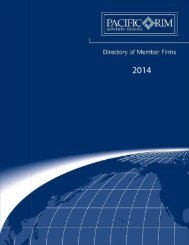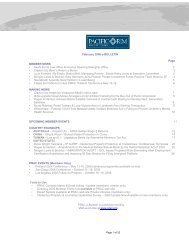The Head Company can change this result by enter<strong>in</strong>g <strong>in</strong><strong>to</strong> a taxshar<strong>in</strong>g agreement with one or more <strong>of</strong> <strong>the</strong> group members. Thetax shar<strong>in</strong>g agreement would seek <strong>to</strong> determ<strong>in</strong>e tax liabilities <strong>of</strong>group members so that, say, a securitisation trust was notburdened with <strong>the</strong> tax liabilities <strong>of</strong> o<strong>the</strong>r group members. A taxshar<strong>in</strong>g agreement must make a reasonable allocation <strong>of</strong> grouptax liabilities. Regulations will be created that set out fur<strong>the</strong>rrequirements (if any) for such an agreement. A tax shar<strong>in</strong>gagreement will only be enforceable aga<strong>in</strong>st <strong>the</strong> Commissioner if<strong>the</strong> agreement was not entered <strong>in</strong><strong>to</strong> for <strong>the</strong> purpose <strong>of</strong>prejudic<strong>in</strong>g <strong>the</strong> Commissioner’s recovery powers.Where a securitisation vehicle is not wholly owned <strong>the</strong>n <strong>the</strong>consolidation rules will not be relevant.5.8 Goods and services tax issues relevant <strong>to</strong> securitisation5.8.1 OverviewA goods and services tax (GST) was <strong>in</strong>troduced <strong>in</strong><strong>to</strong> <strong>Australia</strong> on1 July 2000. GST is imposed on supplies <strong>in</strong>clud<strong>in</strong>g <strong>the</strong> provision<strong>of</strong> goods, services, rights or <strong>in</strong>formation. A supply may be outside<strong>the</strong> scope <strong>of</strong> GST because <strong>the</strong> supply is not connected with<strong>Australia</strong> or because <strong>the</strong> supply is made by an entity that is notregistered or required <strong>to</strong> be registered for GST purposes. O<strong>the</strong>rsupplies may not give rise <strong>to</strong> a GST liability because <strong>the</strong> supplybelongs <strong>to</strong> a class <strong>of</strong> supply that is identified by <strong>the</strong> GST law asbe<strong>in</strong>g excluded from <strong>the</strong> def<strong>in</strong>ition <strong>of</strong> “taxable supplies”.5.8.2 Input tax creditsAs is typical <strong>of</strong> GST and VAT systems, under <strong>the</strong> <strong>Australia</strong>n GSTsystem, registered GST entities may claim a credit for <strong>the</strong> GST<strong>in</strong>cluded <strong>in</strong> <strong>the</strong> price paid for goods and services acquired for <strong>the</strong>bus<strong>in</strong>ess purposes <strong>of</strong> that entity. Such credits are known as <strong>in</strong>puttax credits. No <strong>in</strong>put tax credit may be claimed <strong>to</strong> <strong>the</strong> extent that<strong>the</strong> acquisition is made for a private or domestic purpose <strong>of</strong> <strong>the</strong>entity. As discussed below, fur<strong>the</strong>r limitations exist on <strong>the</strong> ability<strong>of</strong> an entity <strong>to</strong> claim <strong>in</strong>put tax credits <strong>to</strong> <strong>the</strong> extent an acquisitionrelates <strong>to</strong> <strong>in</strong>put taxed supplies (such as f<strong>in</strong>ancial supplies) be<strong>in</strong>gmade by <strong>the</strong> entity.5.8.3 Types <strong>of</strong> suppliesA number <strong>of</strong> different types <strong>of</strong> supplies are specifically identified<strong>in</strong> <strong>the</strong> <strong>Australia</strong>n GST system. There are three pr<strong>in</strong>cipalcategories <strong>of</strong> supplies that are identified:• taxable supplies;• GST-free supplies; and• <strong>in</strong>put taxed supplies.Taxable suppliesGST is payable by a registered GST entity on <strong>the</strong> taxable suppliesmade by that entity. A supply will constitute a taxable supply if<strong>the</strong> follow<strong>in</strong>g requirements <strong>in</strong> section 9-5 <strong>of</strong> <strong>the</strong> A New TaxSystem (Goods and Services Tax) Act 1999 (<strong>the</strong> GST Act) aresatisfied:“(a) <strong>the</strong> supply is made for consideration;(b) <strong>the</strong> supply is made <strong>in</strong> <strong>the</strong> course or fur<strong>the</strong>rance <strong>of</strong> anenterprise that <strong>the</strong> supplier carries on;(c) <strong>the</strong> supply is connected with <strong>Australia</strong>; and(d) <strong>the</strong> supplier is registered or required <strong>to</strong> be registered.”All such supplies will be taxable except <strong>to</strong> <strong>the</strong> extent that <strong>the</strong>supply is identified by <strong>the</strong> GST law as ei<strong>the</strong>r GST-free or <strong>in</strong>puttaxed.GST-free suppliesGST is not payable on supplies that are GST-free. Most supplies<strong>in</strong> <strong>the</strong> context <strong>of</strong> securitisations will be supplies <strong>of</strong> “th<strong>in</strong>gs” o<strong>the</strong>rthan goods or real property. Such supplies would <strong>in</strong>clude servicesand most debt <strong>in</strong>struments (o<strong>the</strong>r than <strong>the</strong> mortgages<strong>the</strong>mselves). Such supplies will be GST-free if <strong>the</strong> follow<strong>in</strong>grequirements are satisfied:(a) <strong>the</strong> supply is made <strong>to</strong> a non-resident who is not “<strong>in</strong><strong>Australia</strong>” when <strong>the</strong> th<strong>in</strong>g supplied is done, and ei<strong>the</strong>r:(i) <strong>the</strong> supply is nei<strong>the</strong>r a supply <strong>of</strong> work physicallyperformed on goods situated <strong>in</strong> <strong>Australia</strong> when <strong>the</strong> workis done, nor a supply directly connected with real propertysituated <strong>in</strong> <strong>Australia</strong>; or(ii) <strong>the</strong> non-resident acquires <strong>the</strong> th<strong>in</strong>g <strong>in</strong> carry<strong>in</strong>g on itsenterprise, but is not registered or required <strong>to</strong> beregistered (refer Item 2 <strong>of</strong> section 38-190(1) <strong>of</strong> <strong>the</strong> GSTAct); or(b) <strong>the</strong> supply is made <strong>to</strong> a recipient who is not “<strong>in</strong> <strong>Australia</strong>”when <strong>the</strong> th<strong>in</strong>g supplied is done and <strong>the</strong> effective use andenjoyment <strong>of</strong> <strong>the</strong> supply takes place outside <strong>Australia</strong> o<strong>the</strong>rthan a supply directly connected with real property situated<strong>in</strong> <strong>Australia</strong> (refer Item 3 <strong>of</strong> section 38-190(1) <strong>of</strong> <strong>the</strong> GSTAct).Therefore, a determ<strong>in</strong>ation <strong>of</strong> whe<strong>the</strong>r or not an entity is “<strong>in</strong><strong>Australia</strong>” will be critical <strong>in</strong> determ<strong>in</strong><strong>in</strong>g we<strong>the</strong>r or not a supply is<strong>to</strong> a non-resident will be GST-free. Detailed guidance <strong>of</strong> <strong>the</strong><strong>Australia</strong>n Taxation Office’s views are set out <strong>in</strong> GST Rul<strong>in</strong>gGSTR 2004/7.37
Entities that make GST-free supplies will be entitled <strong>to</strong> <strong>in</strong>put taxcredits for <strong>the</strong> GST components <strong>in</strong>cluded <strong>in</strong> <strong>the</strong> cost <strong>of</strong> <strong>the</strong>iracquisitions that relate <strong>to</strong> <strong>the</strong> mak<strong>in</strong>g <strong>of</strong> those supplies.Input taxed suppliesGST is not payable on supplies that are <strong>in</strong>put taxed. Thedist<strong>in</strong>ction between <strong>in</strong>put taxed supplies and GST-free supplies(discussed above) is that an entity may be restricted <strong>in</strong> its ability<strong>to</strong> claim <strong>in</strong>put tax credits because <strong>of</strong> <strong>the</strong> <strong>in</strong>put taxed suppliesmade by that entity.There are two ma<strong>in</strong> types <strong>of</strong> <strong>in</strong>put taxed supplies, namely <strong>in</strong>puttaxed f<strong>in</strong>ancial supplies and o<strong>the</strong>r <strong>in</strong>put taxed supplies (such as<strong>the</strong> leas<strong>in</strong>g <strong>of</strong> residential premises). Generally, an entity will beunable <strong>to</strong> claim any <strong>in</strong>put tax credits for acquisitions, <strong>to</strong> <strong>the</strong>extent <strong>the</strong>y relate <strong>to</strong> <strong>the</strong> mak<strong>in</strong>g <strong>of</strong> <strong>in</strong>put taxed supplies.However, <strong>the</strong>re are three important exceptions <strong>in</strong> relation <strong>to</strong><strong>in</strong>put taxed f<strong>in</strong>ancial supplies.First, a reduced <strong>in</strong>put tax credit may be claimed for reduced creditacquisitions which relate <strong>to</strong> mak<strong>in</strong>g f<strong>in</strong>ancial supplies.The reduced <strong>in</strong>put tax credit is a credit equal <strong>to</strong> 75 percent <strong>of</strong> <strong>the</strong>GST <strong>in</strong>cluded <strong>in</strong> <strong>the</strong> consideration provided by <strong>the</strong> entity for thatacquisition. Reduced <strong>in</strong>put tax credits are only available for <strong>the</strong>reduced credit acquisitions that are exhaustively listed <strong>in</strong> <strong>the</strong> GSTlaw.Secondly, an entity will not be precluded from claim<strong>in</strong>g an <strong>in</strong>puttax credit for an acquisition <strong>to</strong> <strong>the</strong> extent <strong>the</strong> acquisition relates<strong>to</strong> <strong>the</strong> mak<strong>in</strong>g <strong>of</strong> f<strong>in</strong>ancial supplies and <strong>the</strong> entity mak<strong>in</strong>g <strong>the</strong>acquisition does not exceed <strong>the</strong> f<strong>in</strong>ancial acquisitions threshold.An entity will exceed <strong>the</strong> f<strong>in</strong>ancial acquisitions threshold ifei<strong>the</strong>r:“(a) <strong>the</strong> amount <strong>of</strong> all <strong>in</strong>put tax credits <strong>to</strong> which that entity wouldbe entitled for ‘f<strong>in</strong>ancial acquisitions’ would exceed $50,000; or(b) <strong>the</strong> amount <strong>of</strong> <strong>in</strong>put tax credits <strong>to</strong> which that entity would beentitled for ‘f<strong>in</strong>ancial acquisitions’ would exceed 10% <strong>of</strong> <strong>the</strong><strong>to</strong>tal amount <strong>of</strong> <strong>the</strong> <strong>in</strong>put tax credits <strong>to</strong> which <strong>the</strong> entitywould be entitled for acquisitions and importations dur<strong>in</strong>gthat 12 month period.”Therefore, <strong>the</strong> question <strong>of</strong> whe<strong>the</strong>r or not an entity exceeds <strong>the</strong>f<strong>in</strong>ancial acquisitions threshold turns not on <strong>the</strong> value <strong>of</strong> f<strong>in</strong>ancialsupplies made by that entity but ra<strong>the</strong>r, <strong>the</strong> value <strong>of</strong> <strong>the</strong>acquisitions made by that entity that are attributable <strong>to</strong> thosef<strong>in</strong>ancial supplies.F<strong>in</strong>ally, an entity will not be denied an <strong>in</strong>put tax credit foracquisitions that are made <strong>in</strong> <strong>the</strong> course <strong>of</strong> mak<strong>in</strong>g a f<strong>in</strong>ancialsupply consist<strong>in</strong>g <strong>of</strong> a borrow<strong>in</strong>g, provided that <strong>the</strong> borrow<strong>in</strong>g isnot for <strong>the</strong> purpose <strong>of</strong> mak<strong>in</strong>g <strong>in</strong>put taxed f<strong>in</strong>ancial supplies.Fur<strong>the</strong>r, such acquisitions will not be counted <strong>in</strong> determ<strong>in</strong><strong>in</strong>gwhe<strong>the</strong>r or not <strong>the</strong> entity mak<strong>in</strong>g <strong>the</strong> acquisition exceeds <strong>the</strong>f<strong>in</strong>ancial acquisitions threshold.F<strong>in</strong>ancial suppliesOf <strong>the</strong> categories <strong>of</strong> <strong>in</strong>put taxed supplies, <strong>the</strong> most significant <strong>in</strong><strong>the</strong> context <strong>of</strong> securitisations are <strong>the</strong> <strong>in</strong>put taxed f<strong>in</strong>ancialsupplies. The <strong>Australia</strong>n GST system only provides <strong>in</strong>put taxedtreatment for f<strong>in</strong>ancial supplies that <strong>in</strong>volve <strong>the</strong> provision,acquisition or disposal <strong>of</strong> various <strong>in</strong>terests. Services relat<strong>in</strong>g <strong>to</strong><strong>the</strong> mak<strong>in</strong>g <strong>of</strong> f<strong>in</strong>ancial supplies, such as arrang<strong>in</strong>g services, arenot provided with <strong>in</strong>put taxed treatment and will generally betaxable.Regulation 40-5.09 <strong>of</strong> <strong>the</strong> A New Tax System (Goods andServices Tax) Regulations 1999 (<strong>the</strong> “GST Regulations”) def<strong>in</strong>es<strong>the</strong> scope <strong>of</strong> f<strong>in</strong>ancial supplies. Pursuant <strong>to</strong> subparagraph (1) <strong>of</strong>that regulation, <strong>the</strong> provision, acquisition or disposal <strong>of</strong> an<strong>in</strong>terest mentioned <strong>in</strong> subparagraph (3) or (4) is a f<strong>in</strong>ancial supplyif:“(a) <strong>the</strong> provision, acquisition or disposal [<strong>of</strong> <strong>the</strong> <strong>in</strong>terest] is:(i) for consideration;(ii) <strong>in</strong> <strong>the</strong> course or fur<strong>the</strong>rance <strong>of</strong> an enterprise; and(iii) connected with <strong>Australia</strong>; and(b) <strong>the</strong> supplier is:(i) registered or required <strong>to</strong> be registered; and(ii) a f<strong>in</strong>ancial supply provider <strong>in</strong> relation <strong>to</strong> <strong>the</strong> supply <strong>of</strong> <strong>the</strong><strong>in</strong>terest.”Because f<strong>in</strong>ancial supplies are <strong>in</strong>put taxed, entities that makef<strong>in</strong>ancial supplies are not liable <strong>to</strong> remit GST on <strong>the</strong> value <strong>of</strong>those supplies. Subject <strong>to</strong> <strong>the</strong> exceptions identified above,entities will be restricted <strong>in</strong> <strong>the</strong>ir ability <strong>to</strong> claim <strong>in</strong>put tax creditsfor acquisitions relat<strong>in</strong>g <strong>to</strong> <strong>the</strong> mak<strong>in</strong>g <strong>of</strong> f<strong>in</strong>ancial supplies.Regulation 40-5.12 <strong>of</strong> <strong>the</strong> GST Regulations sets out a table <strong>of</strong>supplies that are specifically identified as not be<strong>in</strong>g <strong>in</strong>put taxedf<strong>in</strong>ancial supplies. These supplies will be taxable provided that<strong>the</strong>y are not <strong>in</strong>cidental f<strong>in</strong>ancial supplies (discussed below) andprovided that <strong>the</strong> general requirements <strong>of</strong> a taxable supply aresatisfied.In <strong>the</strong> event <strong>of</strong> any conflict between regulations 40-5.09 and 40-5.12, regulation 40-5.12 will prevail – that is, <strong>the</strong> supply not bean <strong>in</strong>put taxed f<strong>in</strong>ancial supply.38






